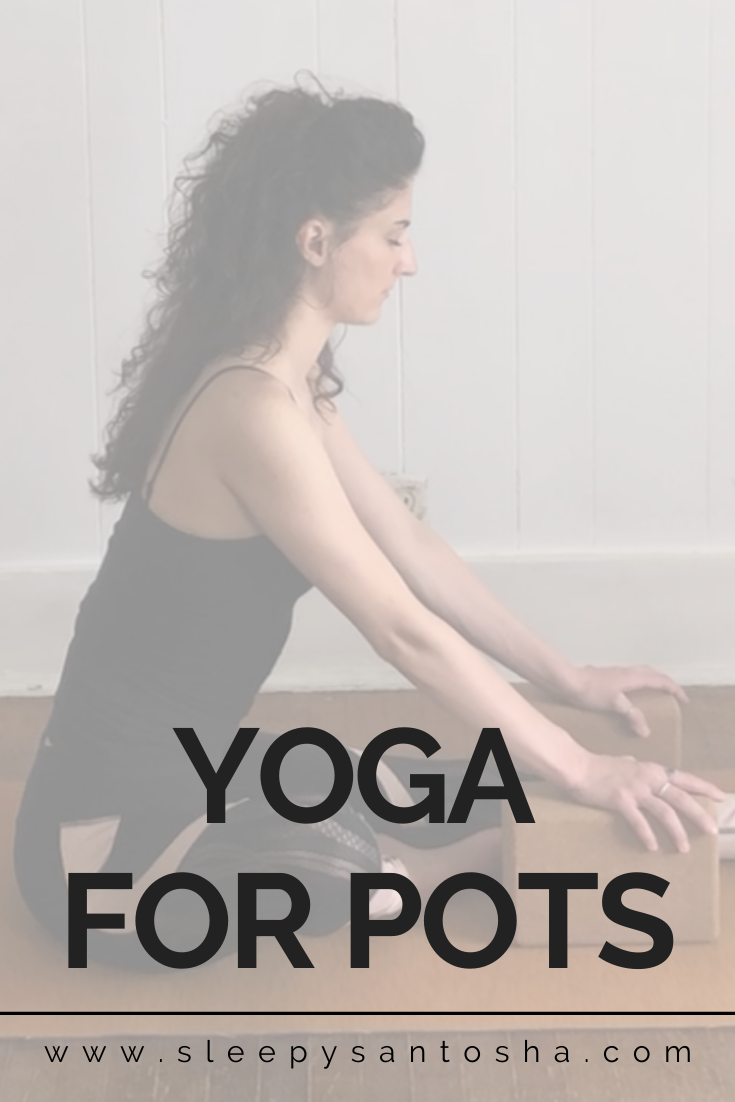3 TIPS FOR PRACTICING YOGA WITH POTS
The three months I spent bedbound in 2017 were some of the scariest months of my life.
Earlier that fall my doctor told me I had to quit my job because I was nearly fainting every day and we still didn’t know why. I remember crying as I hugged my manager and coworkers, not knowing that my condition would deteriorate even more after that last day at work.
For the next three months I could only get out of bed to go to the bathroom, and I started to fear that this would be my life forever. I clung to my yoga practice during that time. Most days I was just meditating in bed or doing some simple bed yoga stretches if I could manage the activity. But it kept me calm during those months when I had such frightening symptoms and could barely function. It kept me centered. Reminded me that nothing is forever. And that I am so much more than my physical body.
Finally, in November 2017 we knew what was wrong — I had Postural Orthostatic Tachycardia Syndrome (POTS).
Even just having a diagnosis on paper gave me tremendous relief. Living in a sick body without a diagnosis can be both terrifying and invalidating. To see those words on paper. To know it wasn’t my fault or that I was imagining things gave me so much comfort along with the knowledge that we could start managing my symptoms so I could have a better life.
Looking back, I realize I’d been having symptoms of POTS for a long time, even back into my high school days when I was struggling to keep up with my peers in sports and experiencing daily unexplained headaches, migraines and nausea. I’m not sure what caused my symptoms to flare up so severely in 2017, but now I’m much better at handling those flare ups if and when they happen again.
Because of my yoga practice, I am able to work part time teaching yoga for chronic illness online and do things like comfortably sit upright while I type this blog post.
When you have POTS, your yoga practice will need to look a little different than the practices others are doing. But that doesn’t mean you won’t still get huge benefits out of your practice!
Here are three things to remember when practicing yoga with POTS:
1. MOVE SLOWLY AND MINDFULLY
When practicing yoga, enter and exit each pose slowly. This is especially true for inversions (poses where your head is below your heart). The most common example of an inversion would be standing forward fold (uttanasana). Instead of standing up in one fluid movement, pause halfway with the back parallel to the floor before coming all the way up. You could also drop into a chair pose before pressing all the way up to standing. This engages your muscles so blood flow is encouraged to go back up toward your head. You can apply this same concept to other pose transitions as well.
You may want to avoid more challenging inversions like handstand or forearm stand for now, but that doesn’t mean they’re off the table forever. Start with easier inversions like legs up the wall pose, downward dog and standing forward fold. As long as you are practicing safely, these poses may actually improve your POTS symptoms because you’re increasing your body’s ability to tolerate changes in posture.
Anytime you change your posture from a supine pose to seated or from seated to standing, you’ll need to move slowly between these poses, too.
2. AVOID DEEP BACK BENDS
Deep back bends like wheel pose or king pigeon stimulate the nervous system, which can aggravate POTS symptoms. Some of my students with POTS have told me that even small backbends like cobra pose or cat/cow stretches can aggravate their symptoms, too. Listen to your body. If any poses make you dizzy, start to blur your vision or trigger headaches, reach out to your yoga teacher for alternative poses or omit these poses from your practice completely.
Like inversions, these poses may not be off the table for you forever as you build your tolerance over time.
3. DO YOUR ENTIRE PRACTICE LYING DOWN
Yes! This is an option! Practicing lying down will be safer, especially when you’re just getting started. But don’t think this means your practice has to be boring or easy!
Poses done standing up can be flipped around so that you can experience the same stretch and strengthening benefits of these poses while lying down. Not to mention the many strengthening yoga postures (like bridge pose!) that are done traditionally lying down anyway. Get creative with your practice! There is always more than one way of doing something.
Ready to get started? Check out these free POTS-friendly yoga classes on YouTube.
Condition your body to be able to sit upright with one of my members-only training plans. Click here to learn more about membership.


